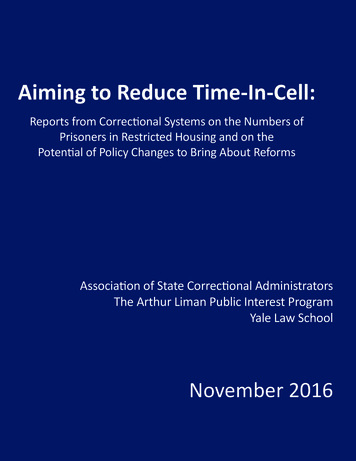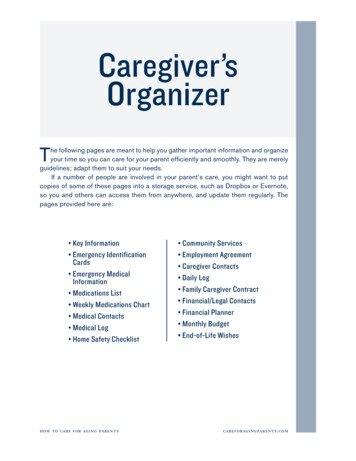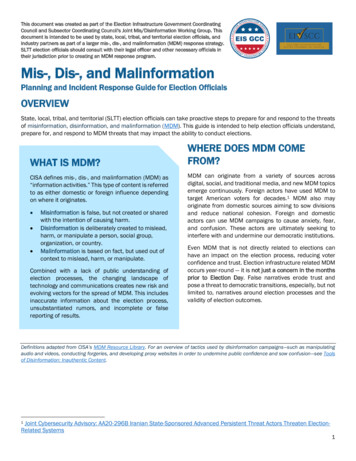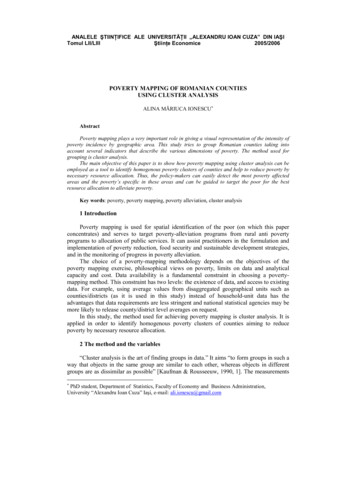
Transcription
Aiming to Reduce Time-In-Cell:Reports from Correctional Systems on the Numbers ofPrisoners in Restricted Housing and on thePotential of Policy Changes to Bring About ReformsAssociation of State Correctional AdministratorsThe Arthur Liman Public Interest ProgramYale Law SchoolNovember 2016
Embargoed until 3pm on November 30, 2016Contacts: George or Camille Camp 301-791-2722; gcamp@asca.netJudith Resnik, 203-432-1447; judith.resnik@yale.eduAiming to Reduce Time-In-Cell: Correctional Administrators and Yale Law School’s LimanProgram Release New Report on Efforts to Reduce the Use of Isolationin State and Federal PrisonsNew Information from Prison Officials Reflects the National Consensuson the Need to Reduce Reliance on Restricted HousingA new report, jointly authored by the Association of State Correctional Administrators(ASCA) and the Arthur Liman Program at Yale Law School, reflects a profound change in thenational discussion about the use of what correctional officials call “restrictive housing” and whatis popularly known as “solitary confinement.” Just published, Aiming to Reduce Time-In-Cellprovides the only current, comprehensive data on the use of restricted housing, in whichindividuals are held in their cells for 22 hours or more each day, and for 15 continuous days ormore at a time. The Report also documents efforts across the country to reduce the number ofpeople in restricted housing and to reform the conditions in which isolated prisoners are held inorder to improve safety for prisoners, staff, and communities at large.The 2016 publication follows the 2015 ASCA-Liman Report, Time-In-Cell, whichdocumented the use of restricted housing as of the fall of 2014. As ASCA explained then,“prolonged isolation of individuals in jails and prisons is a grave problem in the United States.”Today, a national consensus has emerged focused on limiting the use of restricted housing, andmany new initiatives, as detailed in the report, reflect efforts to make changes at both the stateand federal levels.The 2016 Report is based on survey responses from 48 jurisdictions (the Federal Bureauof Prisons, 45 states, the District of Columbia, and the Virgin Islands)—that held about 96% ofthe nation’s prisoners convicted of a felony. That number excludes people held in most of thecountry’s jails (housing hundreds of thousands of people), in most of the country’s juvenilefacilities, and in military and immigration facilities.Tallying the responses, the new 2016 Report found that 67,442 prisoners were held, inthe fall of 2015, in prison cells for 22 hours or more for 15 continuous days or more. Thepercentages of prisoners in restricted housing in federal and state prisons ranged from under 1%Page 1
to more than 28%. Across all the jurisdictions, the median percentage of the prison populationheld in restricted housing was 5.1%.How long do prisoners remain in isolation? Forty-one jurisdictions provided informationabout the length of stay for a total of more than 54,000 people in restricted housing.Approximately 15,725 (29%) were in restricted housing for one to three months; at the other endof the spectrum, almost 6,000 people (11%) across 31 jurisdictions had been in restricted housingfor three years or more.The Report also chronicles efforts throughout the country and the world to reduce the useof restricted housing. In August of 2016, the American Correctional Association (ACA) approvednew standards, calling for a variety of limits on the use of isolation, including a prohibitionagainst placing prisoners in restricted housing on the basis of their gender identity alone. Thestandards also included provisions that pregnant women, prisoners under the age of 18, andprisoners with serious mental illness ought not be placed for extended periods of time in restrictedhousing. Further, in some jurisdictions, prison systems (sometimes prompted by legislation andlitigation) have instituted rules to prevent vulnerable populations from being housed in restrictedhousing except under exceptional circumstances and for as short an amount of time as possible.As the Report also details, several jurisdictions described making significant revisions tothe criteria for entry, so as to limit the use of restricted housing, as well as undertaking morefrequent reviews to identify individuals to return to general population, thereby reducing thenumber of people in restricted housing by significant percentages.In short, while restricted housing once was seen as central to prisoner management, by2016 many prison directors and organizations such as ASCA and the ACA have defined restrictedhousing as a practice to use only when absolutely necessary and for only as long as absolutelyrequired. The goals of ASCA and the ACA are to formulate and to apply policies to improve thesafety of institutions and communities by ensuring that the separation of individuals to promotesafety and well-being need not be accompanied by deprivation of all opportunities for socialcontact, education, programming, and other activities.As Leann K. Bertsch, President of ASCA, explained:“What we are seeing is that prison systems are motivated to reduce the use ofisolation in prisons and are actively putting into place policies designed toreduce the use of restrictive housing. Restricted housing places substantialstress on both the staff working in those settings as well as the prisoners housedin those units. Our highest priority is to operate institutions that are safe forstaff and inmates and to keep communities to which prisoners will return safe.”For more information, please contact George and Camille Camp, Co-Executive Directorsof ASCA, at 301-791-2722, and Judith Resnik, Arthur Liman Professor of Law at Yale LawSchool, at 203-432-1447. The full report may be downloaded, free of charge, at www.asca.net Page 2
Aiming to Reduce Time-In-Cell:Reports from Correctional Systems on theNumbers of Prisoners in Restricted Housingand on the Potential of Policy Changesto Bring About ReformsAssociation of State Correctional AdministratorsThe Arthur Liman Public Interest Program, Yale Law SchoolNovember 2016ASCA-Liman Aiming to Reduce Time-In-Cell November 21, 2016
AssociationofStateCorrectionalAdministrators (ASCA)ASCA is the association of persons directlyresponsible for the administration ofcorrectional systems. ASCA includes theheads of state corrections agencies, theFederal Bureau of Prisons, the District ofColumbia Department of Corrections, andsome large county jail systems. Founded inthe 1950s, ASCA gained its currentorganizational structure in the 1980s. ASCAis premised on the belief that eachrepresented correctional jurisdiction isunique in its own obligations, structures, andresources and that similarities of purpose,responsibilities, and challenges amongmember jurisdictions unite them in a questfor public safety, secure and orderlyfacilities, and professionalism.The Arthur Liman Public InterestProgram, Yale Law SchoolThe Arthur Liman Public Interest Programwas endowed to honor one of Yale LawSchool’s most accomplished graduates,Arthur Liman, who graduated in 1957 andwho personified the ideal of commitment tothe public interest. Throughout hisdistinguished career, he demonstrated howdedicated lawyers, in both private practiceand public life, can serve the needs ofpeople and causes that might otherwise gounrepresented. The Liman Program wascreated in 1997 to continue thecommitments of Arthur Liman bysupporting lawyers, in and outside theacademy, who are dedicated to publicservice in the furtherance of justice.AcknowledgementsThis report is based on a survey co-authoredby ASCA and by the Liman Program at YaleLaw School. The research and report teamswere led by George and Camille Camp ofASCA and by Professor Judith Resnik,former Director Johanna Kalb and currentDirector Anna VanCleave of the LimanProgram, former Senior Liman Fellow inResidence Sarah Baumgartel and currentSenior Fellow Kristen Bell, all of Yale LawSchool. Olevia Boykin, Corey Guilmette,Tashiana Hudson, Diana Li, Joseph Meyers,Hava Mirell, and Jessi Purcell, current andformer students at Yale Law School,conducted the research and drafted thisreport.Thanks are due to all the jurisdictions thatresponded to the survey, and for theirthoughtful comments and reviews receivedafter drafts of the report were circulated inthe winter of 2016 and in the summer of2016. Yale Law School, the Liman Program,the Vital Projects Fund, and the Oscar M.Ruebhausen Fund at Yale Law School havegenerously supported this project. Specialthanks are due to Skylar Albertson, AlisonGifford, and Bonnie Posick for experteditorial advice.To download copies of this Report, pleasevisit the website of the Liman Program r-liman-public-interest-program/limanpublications. This Report may bereproduced free of charge and without theneed for additional permission. All rightsreserved, 2016.Inquiries:George and Camille CampCo-Executive Directors of ASCAgcamp@asca.net; ccamp@asca.netJudith ResnikArthur Liman Professor of LawYale Law Schooljudith.resnik@yale.eduASCA-Liman Aiming to Reduce Time-In-Cell November 21, 2016
2Table of ContentsI.LEARNING ABOUT ISOLATION IN PRISONA. Collecting Data to Establish Baselines and Parameters: 2012-2015B. Looking for Changes: 2015-2016C. The Context: Demands for Change4468II. THE 2015 SURVEY’S DESIGN AND PURPOSESA. Goals and MethodsB. Research Challenges: Various Definitions of Restricted Housingand the Overlaps and Differences between the 2015 and 2016ASCA-Liman Reports1515III. TYPES OF FACILITIES AND OF CELLS IN THE 2015 SURVEYA. Types of Facilities for which State-Wide Data Were AvailableB. The Use of Single and of Double Cells171719IV. THE NUMBERS AND PERCENTAGES OF PRISONERS IN RESTRICTEDHOUSING: THE DATA FROM THE 2015 SURVEYA. Counting and Comparing General and Restricted PopulationsB. The Numbers and Percentages of Prisoners In-Cell for 16 to 21 Hours20202416V. THE DURATION OF TIME INDIVIDUALS SPENT IN RESTRICTED HOUSING 26A. Length of Time26B. Length of Time by Classification of the Type of Restricted Custody29VI. THE DEMOGRAPHICS OF RESTRICTED HOUSINGA. GenderB. Race and EthnicityC. Age CohortsD. Vulnerable Populations: Mentally Ill, Pregnant, and Transgender Prisoners1. Prisoners with Serious Mental Health Issues(according to each jurisdiction’s own definition)2. Pregnant Prisoners3. Transgender PrisonersVII. PLANNED OR PROPOSED POLICY CHANGESIN RESTRICTED HOUSING: 2013-2016A. Reducing Placement in Restricted Housing:Narrowing Criteria for Entry and Creating AlternativesB. Focusing on Release: Time Caps, Step-Down Programs, andIncreased Oversight of Retention DecisionsC. Mandated Time Out-of-CellD. Conditions: The Physical Environment and ProgrammingE. Staffing: Policies and Training3030354248485455555657585959ASCA-Liman Aiming to Reduce Time-in-Cell December 6, 2016
3F.VIII.Jurisdictions Seeking Substantial Reductions in Restricted Housing Use1. The Federal Prison System: Changes Recommended in the2016 Department of Justice Restricted Housing Report2. Colorado3. North Dakota4. Ohio5. South Carolina6. Utah60606264656669REFLECTING ON EFFORTS TO REDUCE TIME-IN-CELL71ENDNOTESAPPENDICESAppendix A:Appendix B:Appendix C:ASCA-Liman Restricted Housing Survey – Fall 2015List of the Report’s Charts and TablesJurisdictions’ Definitions of Serious Mental IllnessASCA-Liman Aiming to Reduce Time-in-Cell December 6, 2016
4I.Learning about Isolation in PrisonThis Report is the third in a series that examines what correctional officials in the UnitedStates call “restrictive housing” and what is known more generally as “solitary confinement.”Working together, the Association of State Correctional Administrators (ASCA) and the ArthurLiman Program at Yale Law School have sought to understand the formal rules governingaspects of the segregation of prisoners in the United States; the numbers of individuals confined;the conditions under which they live; and the limits on the use of isolation.Below, we provide a brief overview of prior ASCA-Liman work in this area, adescription of this study, and a review of initiatives during the last few years aimed at producingsignificant reforms to reduce the numbers of people in restricted housing and the degrees of theirisolation.A.Collecting Data to Establish Baselines and Parameters: 2012-2015Prison systems across the United States separate some prisoners from general populationand put them into special housing units, typically with more isolating conditions. The reasons fordoing so include the imposition of punishment (“disciplinary segregation”), protection(“protective custody”), and incapacitation (often termed “administrative segregation”).In Administrative Segregation, Degrees of Isolation, and Incarceration: A NationalOverview of State and Federal Correctional Policies, published in 2013, we asked directors ofstate and federal corrections systems to provide their policies on administrative segregation,defined as removing a prisoner from general population to spend 22 to 23 hours a day in a cellfor 30 days or more.1 Administrative segregation was the form of confinement that we believedwas the most common basis for segregation.What we learned, based on responses from 47 jurisdictions, was that correctional policiesmade getting into segregation relatively easy, and few systems focused on getting people out.The criteria for entry were broad. Many jurisdictions permitted moving a prisoner intosegregation if that prisoner posed a threat to institutional safety or a danger to self, staff, or otherinmates. Constraints on decision-making were minimal; the kind of notice provided and whatconstituted a “hearing” varied substantially.In 2014, the Liman Program and ASCA took the next step by asking correctionaladministrators more than 130 questions—this time about the numbers of people in restrictedhousing and the conditions under which they lived.2 The overall focus was on a subset ofrestricted housing—“administrative segregation,” while a few questions focused on all forms ofrestricted housing. Responses came from 46 jurisdictions (albeit not all jurisdictions answered allthe questions). Published in 2015, the Time-In-Cell Report provided a unique multi-jurisdictionalwindow into segregation.A central question is about the numbers of individuals in segregation, regardless of thedifferent names under which the practice goes. Before that Report, information on the number ofprisoners held in restricted housing was a decade old or more; the figure often cited was 25,000.3The 2015 ASCA-Liman Report provided new information. What we learned from the 34ASCA-Liman Aiming to Reduce Time-in-Cell December 6, 2016
5jurisdictions answering this question and housing about 73% of the more than 1.5 million peopleincarcerated in U.S. prisons, was that they reported a total of more than 66,000 people held inrestricted housing as of the fall of 2014. Given that number, ASCA and Liman estimated thatsome 80,000 to 100,000 people were, in 2014, in restricted housing (however termed) in U.S.prisons—or about one in every six or seven prisoners.4 Those figures, in turn, did not includejails, juvenile facilities, or immigration and military detention.We also learned that prisoners in many jurisdictions across the country were required tospend 23 hours in their cells on weekdays and in many, 24 hours in their cells on weekends.5Jurisdictions reported that cells, sometimes holding two people, ranged in size from 45 to 128square feet.6Opportunities for social contact, such as out-of-cell time for exercise, visits, andprograms, were limited, ranging from three to seven hours a week in many jurisdictions.7 Phonecalls and social visits could be as infrequent as once per month. A few jurisdictions providedmore opportunities.8 In most jurisdictions, prisoners’ access to social contact, programs, exercise,and items kept in their cells, could be cut back as sanctions for misbehavior.9Moreover, administrative segregation generally had no fixed endpoint, and severalsystems did not keep track of the numbers of continuous days that people remained in isolation.In the 24 jurisdictions reporting on this question, a substantial number indicated that prisonersremained in segregation for more than three years. As to release and reentry, in 30 jurisdictionstracking the numbers in 2013, a total of 4,400 prisoners were released directly from the isolationof administrative segregation to the outside community.10Running administrative segregation units posed many challenges for prison systems.These problems—coupled with a surge of concerns about the negative impact of isolation onindividuals—have created incentives for change. Prison directors cited prisoner and staff wellbeing, pending lawsuits, and costs as reasons to revise their practices. Some also commented thatchange was important because it was “the right thing to do.”11When releasing Time-In-Cell, ASCA stated that “prolonged isolation of individuals injails and prisons is a grave problem in the United States.”12 As that press release also explained,“insistence on change comes not only from legislators across the political spectrum, judges, anda host of private sector voices, but also from the directors of correctional systems at both stateand federal levels.”13Time-In-Cell provided a window into the prevailing practices and a baseline from whichto assess whether the many efforts to limit isolation would have an impact. That Report madeplain that segregation practices had become entrenched during the past 40 years, that manycorrectional systems sought to make changes, and that unraveling the structures producing somuch isolation would require intensive work.When released in September 2015, the Time-In-Cell Report became front-page news,reflecting the broad concern about these problems and the need for reform.14 Much commentaryfollowed, including several essays published by the Yale Law Journal Forum in January of 2016.ASCA-Liman Aiming to Reduce Time-in-Cell December 6, 2016
6These comments analyzed the data in the Report, the need for reform, and the challenges entailedin making major changes.15B.Looking for Changes: 2015-2016In early October 2015, ASCA and Liman launched this follow-up study to gather nationalinformation on all forms of restricted housing, to learn what numbers of people were in that formof detention in the fall of 2015, and to see what changes were underway. The hope was twofold:that the numbers of people held in such settings were diminishing and that the conditions inrestricted housing were improving by becoming less isolating.This study relied again on asking the directors of prison systems to respond to questions.This time, a set of 15 questions focused on the people in any and all forms of what we termedrestricted housing (or what is also termed “restrictive” housing). We queried 53 jurisdictions (allthe states, the federal system, the District of Columbia, and the Virgin Islands), and 52responded; the one jurisdiction not providing any information was the State of Maine. Asdetailed below, a few jurisdictions that did respond did not have answers to all the topicssurveyed. For many questions, 48 jurisdictions had sufficiently detailed and consistentinformation on which to report,16 and for each topic, we specify the number of respondingjurisdictions.We sought to learn about numbers and demographics—including race, gender identity,age, and mental health status. As the data set forth below reflect, those ambitions were madecomplex by the variety of different facilities under the control of state-wide correctionaldepartments, the many terms used to denote segregating prisoners, the range of data kept, and thelimited amount of data available. The jurisdictions surveyed did not all keep comparable dataabout how many hours, over how many days, prisoners were in their cells.To enable cross-jurisdictional comparisons, we imposed a definition by describingrestricted housing as the separation of prisoners from general population and in detention for 22hours per day or more, for 15 or more continuous days, in single-cells or in double-cells. Thissurvey did not inquire into whether jurisdictions regularly audited their facilities to learn if theparameters were consistently met. For example, we did not ask about what methods were used toensure that individual prisoners were out of their cells for the time stipulated in rules, nor did welearn how often or for how long lockdowns occurred during which no prisoners were permittedto leave cells.Further, if a jurisdiction provided for prisoners to spend 14.5 hours a week out-of-cell, orhad no count of whether prisoners were held 15 days or more, that jurisdiction could havedescribed itself as having no one in restricted housing, even as the jurisdiction understood itselfto have a restricted-housing population. Therefore, and as noted below, in a few instances weincluded information provided by jurisdictions that required minor modifications of our 22hour/15-days-or-more definition.ASCA-Liman Aiming to Reduce Time-in-Cell December 6, 2016
7A preview of some of this Report’s findings is in order. As of the fall of 2015, 67,442people were held in restricted housing across the 48 jurisdictions that reported their numbers.17Relying on data on the United States and its territories from the Bureau of Justice Statistics, welooked at the total number of individuals confined in the 48 jurisdictions, and learned that thesejurisdictions accounted for 96.4% of the total prison population in the United States.18We then calculated the percentage of prisoners who were held in restricted housingacross all of the jurisdictions which regularly kept data on the number of prisoners in restrictedhousing (22 hours a day/15 days or more). The focus was on state prisoners housed under state(not local) control. The percentages of prisoners held in different jurisdictions in restrictedhousing ranged from 0.5% (Hawaii, in-state only) to 28.3% (the Virgin Islands). The median was5.1%.19We also asked about the numbers of people held in segregation between 16 and 21 hoursper day in their cells. Thirty-four jurisdictions responded about those populations. In 23 of thosejurisdictions, we tallied a total of 16,455 additional prisoners in cells for 16 to 21 hours per dayfor 15 consecutive days or more.20 In these 23 jurisdictions, the median so confined was 1.6% oftheir total populations.21 (Eleven of the responding 34 jurisdictions reported that they did nothold prisoners in-cell for 16-21 hours per day for 15 consecutive days or more.)Some of the reporting jurisdictions did not include information on all of the facilitiesdirectly under their control, and very few included information from county and municipal levelfacilities at which prisoners or pretrial detainees were held.22 The dearth of information oncounty jails is important to underscore because counties were responsible, as of 2016, for 91% ofthe jails in the United States, and “11.4 million individuals pass through jail each year.”23 Inshort, through this survey, we have accounted for at least 67,442 individuals in restrictedhousing (22 hours a day/15 days or more) in the fall of 2015. When adding the 16,455 peopleconfined 16 to 21 hours, a total of at least 83,897 prisoners were held in their cells for more than16 hours a day for 15 days or more. Yet, given the data limitations, neither of these numbersincludes all the people held in cell for either 16-hours or more or for 22-hours or more in all ofthe types of U.S. prison and jail facilities.How long, in months and years, did prisoners spend in restricted housing? Forty-onejurisdictions—holding 54,382 prisoners—provided length-of-stay data. Of those prisoners,15,725 people—or 29%—were in restricted housing from one month up to three months. Some15,978 people—or 29%—were in restricted housing for three months up to one year. Another13,041 prisoners—or 24%—were in restricted housing for a year or more. Of these, 2,976people—5.5% of 54,382—had spent from three years to six years in restricted housing. Twentysix jurisdictions reported holding some prisoners—a total of 2,933 people, or 5.4% of the54,382—in restricted housing for six years or more. 24The survey also asked whether correctional systems were making policy-level changes toreduce the use of restricted housing. Forty-five jurisdictions reported on their policies, and manydescribed proposed or recently implemented revisions. Jurisdictions reported policies revisingthe criteria for being placed in isolation to limit its use, increasing the oversight of restrictedhousing, expanded efforts at programming and rehabilitative services in restricted housing,ASCA-Liman Aiming to Reduce Time-in-Cell December 6, 2016
8developing exit paths (sometimes called “step-down” programs), and imposing caps on thelength of time spent in restricted confinement.In addition to summarizing changes in policies, we provide descriptions of effortsreported by a few jurisdictions seeking to make substantial reductions in the use of restrictedhousing. We did not inquire into either the details or metrics of implementation, nor did weconduct case studies to learn about the effects, in practice, of the new policies described.C.The Context: Demands for ChangeAs this study was underway, concerns about restricted housing intensified. In July 2015,President Barack Obama announced that he had directed the Attorney General of the UnitedStates to conduct a review of the use of solitary confinement in the federal prison system.25 Thereview resulted in a report, U.S. Department of Justice Report and RecommendationsConcerning the Use of Restrictive Housing, published in January of 2016. That monographprovided an overview of what the Justice Department termed “restrictive housing” practices inthe federal system and proposals for reform.26 In the same month, in a Washington Post op-edentitled Why we must rethink solitary confinement and which cited the ASCA-Liman Time-InCell Report, the President stated:The Justice Department has completed its review, and I am adopting itsrecommendations to reform the federal prison system. These include banningsolitary confinement for juveniles and as a response to low-level infractions,expanding treatment for the mentally ill and increasing the amount of timeinmates in solitary can spend outside of their cells. These steps will affect some10,000 federal prisoners held in solitary confinement—and hopefully serve as amodel for state and local corrections systems. . . .27The Justice Department’s Report laid out several “Guiding Principles” and “PolicyRecommendations.” The recommendations included ending “the practice of placing juveniles inrestrictive housing.”28 In addition, the Justice Department recommended against placing pregnantwomen in restricted housing, and proposed banning the practice of using the status of LGBTIand gender non-conforming individuals as the sole basis for placement in restricted housing.Further, the Justice Department recommended that, absent special circumstances, seriouslymentally ill prisoners ought not to be placed in restricted housing.29 The Justice Department alsourged the Federal Bureau of Prisons (BOP) to eliminate the use of disciplinary segregation as asanction for “low level” offenses and to reduce the time that prisoners spend in restricted housingfor other offenses.30Further, the Justice Department recommended that prisoners be housed “in the leastrestrictive setting necessary” to ensure the safety of all; that placement be based on specific,“clearly articulate[d]” reasons; and that the placement of prisoners in restricted housing serve “aspecific penological purpose.”31 The Justice Department further recommended that there be “aclear plan for returning the inmate to less restrictive conditions as promptly as possible;”32 thateach individual’s placement in restricted housing be reviewed on a regular basis by a committeethat includes medical and mental health professionals;33 and that restricted housing policiesASCA-Liman Aiming to Reduce Time-in-Cell December 6, 2016
9generally be regularly reviewed by a standing committee that consisted of “high-levelcorrectional officials.”34 The Justice Department called for the BOP to implement these policies,to add “opportunities for out-of-cell time” and programming,35 and to increase transparency inthe use of restricted housing.36In March of 2016, the President issued a Presidential Memorandum, “Limiting the Use ofRestrictive Housing by the Federal Government;” he directed executive departments andagencies to implement the Justice Department’s recommendations.37 President Obama wrote thatin light of “the urgency and importance of this issue, it is critical that DOJ accelerate efforts toreduce the number of Federal inmates and detainees held in restrictive housing and that Federalcorrectional and detention systems be models for facilities across the United States.”38These national efforts came in the context of work in many other venues, ranging fromprofessional associations of correctional and health professionals to state and federal legislaturesand courts, both in the United States and abroad. In 2014, the American Correctional Association(ACA), an umbrella organization comprised of correctional facilities’ leaders from across thecountry, created a Restrictive Housing Ad Hoc Standards Committee to revise its modelstandards.39 The co-chairs, Gary Mohr (the Director of the Ohio Department of Rehabilitationand Correction) and Rick Raemisch (Executive Director of the Colorado Department ofCorrections) wrote in 2015 of the need for an overall reduction in the use of restricted housing;as they explained, “lengthy periods of 23 hours per day in confineme
Page 1 Embargoed until 3pm on November 30, 2016 Contacts: George or Camille Camp 301-791-2722; gcamp@asca.net Judith Resnik, 203-432-1447; judith.resnik@yale.edu










